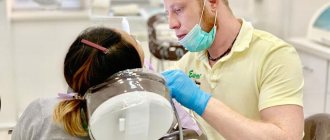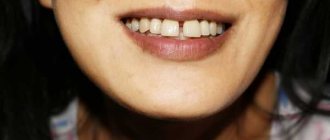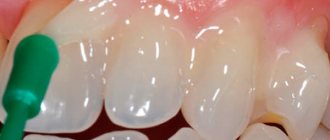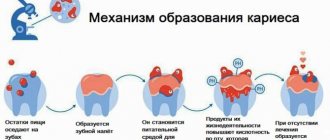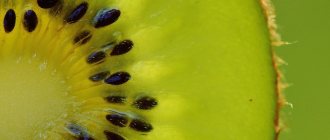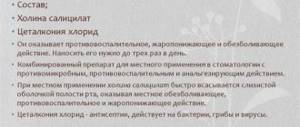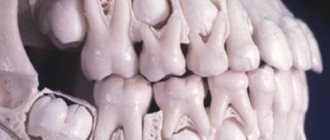Many patients ask dentists: should teeth be a little loose or does this indicate some kind of disease? Some mobility of dental units is observed normally, but it is very small and usually not noticeable. If a person’s teeth are noticeably loose and we are not talking about milk teeth, which should soon be replaced, it is necessary to find the cause of their mobility and eliminate it. Why do teeth become loose in adults, how to treat this pathology and what should be done in this case?
If the tooth is a little loose
If your teeth have just begun to loosen, then you need to urgently take preventive measures. If you don’t know why your teeth have become loose, then it’s better to see a doctor for control.
What to do after being examined by a doctor:
- Brush your teeth and rinse your mouth twice a day.
- Correct the bite if there is deformation.
- Monitor the condition of your gums.
- Eat right, including vegetables, fruits and foods rich in fluoride and calcium in your diet.
These methods will help strengthen your teeth and prevent further loosening.
WATER
Since the human body consists of more than half of water, it is logical to conclude that water is an important product for our body. Water is also good for dental health.
If you drink little water during the day (precisely water. Juices, soda, tea, coffee, soups do not count), among other negative consequences, you will experience a feeling of dry mouth. This means that not enough saliva is produced: a logical consequence of dehydration, because saliva is 98.5% water.
The composition of saliva includes mucins (no more than 0.5% of the total chemical composition of saliva). Due to them, saliva not only has viscosity and elasticity, but also prevents the formation of bacterial plaque, because blocks the proliferation of harmful microorganisms.
However, you need to know that saliva can harm your teeth if you like sweets. In this case, it will contain large amounts of glucose, as a result of which it will only harm tooth enamel.
In addition to the fact that the possibility of salivation that protects teeth depends on water, water helps to mechanically clean the oral cavity of food debris, plaque and acids harmful to tooth enamel.
Part of the molar is movable
Teeth can become loose and fall out in parts. When half a tooth is loose, the dentist takes an x-ray to determine whether the root is affected or only the outer part of the crown is damaged. If the root is not damaged and the base is preserved, then it can be saved. The upper part of the crown is removed and a pin is installed in its place. Then extension is carried out. If the pin cannot be placed, then a polymer filling is placed, and a crown is placed on it. When a tooth becomes very loose and the root is crushed, it is removed and an artificial crown is placed in its place.
Pharmaceutical preparations to strengthen gums
Strengthening the gums is carried out by rinsing 3 times a day with solutions of essential oils (3 grams per 1 glass of water):
- tea tree;
- fir;
- sea buckthorn;
- eucalyptus;
- peppermint.
Compresses with these oils on loose areas are useful.
Medicines and pills
If a person does not believe in traditional methods of strengthening the loose tissues of the mouth and the bone tissues of the teeth, tablets (multivitamins, antioxidants - Mexidol, anti-inflammatory - Analgin), ointments, gels, rinses are at his service.
Vitamins to strengthen gums
Tablet vitamins quickly eliminate the deficiency of necessary substances than organizing a nutritious diet. To strengthen the gums, complexes containing A, B6, B12, C, D, E, phosphorus, calcium for normal metabolism are more useful.
Ointments for weak gums
To prevent teeth from becoming loose, ointments are used to treat gums when loosening begins. Troxevasin strengthens the wall of blood vessels. Heparin ointment stops bleeding and any inflammation, improves microcirculation.
Gels to strengthen loose gums
The dentist should advise how to strengthen the gums – which gel – so as not to harm the loose mucous membrane.
Known gels:
- Asepta.
- Holisal.
- Solcoseryl.
- Metrogyl denta.
- Dental.
- Kamistad.
Some of them only have an anti-inflammatory effect, others additionally strengthen, anesthetize, heal, and disinfect.
Rinse aids
To prevent infection of the loose area after eating, rinsing with a weak solution of potassium permanganate is useful, or use:
- Furacillin.
- Chlorhexidine.
- Hydrogen peroxide.
- Chlorophyllipt.
- Stomatophyte.
- Maraslavin.
- Miramistin.
- Mexidol dent.
- Forest balm.
- President classic plus.
All of them have anti-inflammatory and antiseptic effects, and a number of them have hemostatic effects (hydrogen peroxide, Maraslavin).
Rinse aids containing alcohol should not be used by adults who are about to drive a car or by children.
Strengthening with toothpaste
Medicinal toothpaste for strengthening gums and teeth is purchased at the pharmacy. It is not available in supermarkets.
Toothpastes, the components of which strengthen loose tissues, if teeth are loose, will be recommended by the dentist, taking into account the specific condition of the oral cavity (excess or lack of substances, acidity):
- Paradontax contains many minerals (F, Na, Zn) and plant extracts.
- Lacalut – herbal ingredients, sodium fluoride, aluminum lactate.
- VIVAX – complex of amino acids, betulavit.
- Mexidol Dent Active is an antioxidant.
Pastes are used to eliminate inflammation of loose areas and in preparation for operations on the oral organs.
How effective are gum injections?
Injections into the loose soft tissues of the mouth are effective for quickly relieving inflammation. They are carried out by professional dentists, since each drug has contraindications and the risk of complications. Enter:
- broad-spectrum antibiotics or according to the detected sensitivity of bacteria to them, course – 5–7 days;
- biogenic stimulants (Lidase, FIBS, Aloe extract) to accelerate healing, 1 month;
- antitoxic serums with antibodies to bacterial exotoxins;
- sclerosants (chromium alum, urethane quinine, 40% glucose solution) to strengthen the loose zone;
- Ribonuclease and Methyluracil to stimulate vascular growth;
- plasmolifting – injections into the gums of the patient’s own blood plasma, the most hypoallergenic method, increases immunity, accelerates healing;
- immunomodulators (thymalin, thymogen, galavit, pyrogenal);
- vitamin complexes.
Therapy is carried out taking into account the needs of the individual patient.
What to do after a blow
Dental bruises are closed injuries received after strong mechanical impact. (hitting a hard object). In this case, the teeth remain in place, do not move, but may begin to move. The front ones are especially vulnerable. If your front tooth becomes loose after an impact, you should immediately consult a doctor so that you can save it. X-rays and electroodontodiagnosis are prescribed. The latest diagnostic method makes it possible to see the beginning of the development of tissue necrosis and remove dying particles to prevent inflammation.
As a rule, medications are not used for tooth bruises. Swelling of the gums is relieved with cold compresses, and the patient must be on a liquid diet for some time to keep the molar at maximum rest. Sometimes, dentists practice grinding the cutting edge of the tooth and the cusps of the opposite tooth on the lower jaw, which the patient touches when chewing food.
Oral hygiene rules - recommendations from experts
To strengthen the hard and soft tissues of the oral cavity, it is important to ensure a high level of hygiene. Preventive measures should be mainly aimed at combating thinning and hyperesthesia, mobility of elements and inflammation of periodontal tissues.
Thus, regularity in daily cleaning is not the only condition for maintaining health. It is equally important to perform the procedure correctly and use the correct brush and paste for this. It is better to consult your dentist on this matter, since only a doctor will be able to give an accurate assessment of the current state of the oral tissues, and therefore choose the right direction in prevention.
Proper dental hygiene is important to maintain your smile.
As additional measures, antibacterial and anti-inflammatory rinses, soothing and strengthening gels for gums, the use of floss after meals and an irrigator as part of daily hygiene are often recommended. Once every six months, you must visit a dentist for a preventive examination and a hygienist for a comprehensive professional examination. hygiene: removing plaque, supra- and subgingival deposits, mineralization of hard tissues and strengthening gums.
If the root one is unsteady
Often a healthy tooth begins to hurt sharply and become loose. Permanent teeth can also become loose, even if they are molars. You don’t need to endure it, but go to the dentist. The doctor prescribes disinfectants: rinsing with chlorhexidine and furatsilin solution, gel applications.
If the gums are inflamed, then anti-inflammatory and regenerating drugs are prescribed. (“Trental”, “Olazol”, etc.). Physiotherapy also helps stop the process. For example, vacuum massage, darsonval, ultrasound procedures.
After stopping the inflammatory processes in the oral cavity, the dentist strengthens the teeth in the correct position and applies a temporary splint. If a wisdom tooth is loose and hurts, it is most often removed since it does not play a special role in the chewing process.
REMOVABLE PROSTHETICS AS A METHOD OF SPLINTING
If, in addition to loose teeth, there are also “gaps” formed due to the loss of several teeth in a row, the use of removable dentures is effective. They are used when it is necessary to replace 1–3 teeth in a row. The doctor examines all the nuances regarding the general condition of the dentition, the number of missing teeth, and the presence of bite problems. There is also a dependence of the choice on the age and other individual characteristics of the patient.
There are many materials for making dentures. Some are universal, but expensive. Others are affordable, but are far from ideal in a number of ways, or may cause allergies in some people.
Typically, dental splinting with a removable denture is often chosen as a temporary measure necessary for injuries such as a jaw fracture. During the rehabilitation period, this design provides reliable stability.
Front
The upper front teeth are very mobile, so they often begin to wobble. To find out the reason for this, a comprehensive examination is carried out, including a panoramic photograph of the oral cavity. What to do if your front molar is loose?
After determining the causes, a complete sanitation of the oral cavity is required to destroy infectious pathogens. If periodontal disease is detected, the specialist performs a special massage on the gums, darsonval procedures. If signs of periodontitis are detected, then be sure to remove stones and plaque, and polish the teeth with an ultrasonic beam. The entire surface of the tooth, including the neck, is polished with a brush using medical varnish containing fluoride.
Difficult deposits are removed with curettes, which pass under the gums, pulling out deposits. Open curettage is also performed, where the gum is cut and then stitched back together. Additionally, medications are prescribed that relieve inflammation with an antiseptic effect.
If the upper front teeth of an adult are seriously damaged or separated, a splint is placed on the upper jaw. A small hole is drilled in the molar into which fiberglass is placed. After which everything is covered with any composite substance that reflects light rays. Thus, during the movement of the front jaw, the molars do not move apart.
In the event of a mechanical injury, when part of the crown is broken and the tooth root is damaged, all fragments are removed and artificial crowns are installed in place of the natural tooth. The sooner a patient contacts a dentist with a problem, the higher the success of treatment. In complex cases, surgery may be required.
Traditional medicine tips
To prevent caries and non-carious lesions, you can from time to time resort to traditional medicine. But before you try another recipe on yourself, it is better to consult a dentist and rule out possible contraindications. The most effective and safest tips are described below.
Saline solution
Mix one teaspoon of salt in a glass of warm water, then rinse your mouth thoroughly with the resulting solution. The product has a pronounced antiseptic effect, helps to relieve acute inflammation and reduce pain in pathological conditions.
Oak bark decoction
An effective remedy for restoring gums is prepared using oak bark - it can be purchased at any nearest pharmacy. It is advisable to add linden blossom to the crushed bark in a ratio of 1 to 1. Pour a teaspoon of the mixture with a glass of boiling water and leave for about an hour. After this time, the broth should be filtered and used for its intended purpose up to three times a day.
Gargling with a decoction of oak bark will help in treatment
Propolis tincture
For preventive purposes, you can use an aqueous solution of propolis tincture - for rinsing and applying to the brush. Propolis balls are perfect as medicinal chewing gum. The product has a pronounced bactericidal effect, helps reduce the activity of pathogenic microorganisms and restore the balance of microflora.
The photo shows propolis balls
Beeswax gum
To prepare this product, mix honey, beeswax, lemon juice and peppermint oil in a glass container in a water bath. Next, you need to let the resulting mixture cool until it hardens a little. Then the chewing gum should be cut into small pieces and used for its intended purpose several times a day. An additional effect is pleasant fresh breath.
Medicinal salad recipe
First you need to soak the seaweed in warm water and squeeze it out a little. Next, add basil seasoning and chopped sage. The salad should be chewed thoroughly for 15 minutes, and then it can be swallowed or spat out. This is a great alternative to cleansing after eating or consuming highly acidic foods.
Seaweed is a great alternative to brushing your teeth
What to do if your teeth are loose and your gums hurt
When gums bleed and become inflamed, teeth can also become loose and even fall out. One of the factors that provokes this condition is acute or chronic gingivitis. The inflammatory process provokes a light plaque on the teeth consisting of microbial pathogens or the formation of tartar on the teeth if you do not take good care of the oral cavity. If gingivitis is not treated, the germs travel deeper into the tissue. Periodontitis develops when pus forms on the gums, the necks of the teeth are exposed, and constant pain appears.
With periodontitis, the inflammatory process occurs in the tissues, from the base of the tooth root. At the same time, gumboil appears and the gums become very swollen and painful. Sometimes, due to chronic infection, cysts form on the gums; they do not appear immediately. In severe cases, a granuloma forms on the gums, in which bacteria attack the gums and roots of the teeth. In this case, the person experiences severe itching and high fever.
Also, gums can hurt after tooth extraction, installation of implants, braces, appliances, or improper dental treatment.
If your teeth are loose in your gums, you should not:
- Press your finger on the gum
- Heat with compresses, sand, warm rinses
- Open an abscess at home
- Taking too many painkillers
First of all, you need to relieve pain with pills or injections. But under no circumstances should you exceed the dosage. Paracetamol, analgin, ketanol and other similar products are suitable. You can also use gels with an analgesic and cooling effect.
You can rinse your mouth with Chlorhexidine and Miramistin. This needs to be done in the morning at lunch and in the evening to get results.
Symptoms
In the vast majority of cases, teeth become loose due to advanced caries and the presence of tartar. Clear signs that you will experience periodontal problems in the coming months:
- dark spots on tooth enamel;
- bleeding gums;
- high sensitivity of teeth to cold/hot;
- pain when chewing.
At the initial stage, the amplitude of tooth loosening does not exceed 1 mm. Subsequently, it increases, and the tooth wobbles in all directions. Biting or chewing with it is uncomfortable or even impossible.
Periodontal diseases are most often accompanied by atrophy of the jaw bone. That is, the volume of bone tissue in which the teeth are anchored gradually decreases. This is clearly noticeable by the “sagging” of the gum line, the formation of gum pockets and the increasing exposure of the necks of the teeth. If no measures are taken, bone volume can decrease catastrophically, leading to loose teeth. And this already threatens their loss.
Firming massage
Strengthens loose gums by improving blood flow through massage. Hands must be clean or wear sterile gloves and finger caps. The effect is enhanced by adding pine needle paste, honey or a suitable essential oil.
Grab the jaw with the 1st and 2nd fingers of the hand and massage the loose gums along the jaw in smooth circles for 5–7 minutes, without applying pressure. After the massage, rinse with an antiseptic.
You cannot massage if there is gum bleeding.
Stock
-50%
Manufacturing of removable denture Acry Free 40,000 rub.
20,000 rub.
get -16 %
Premium implantation Nobel and zirconium dioxide crown 125,000 rub.
105,000 rub.
get -13 %
Removable overdenture on 4 implants RUB 150,000.
130,000 rub.
get -16 %
Premium implantation Nobel and zirconium dioxide crown 125,000 rub.
105,000 rub. get
